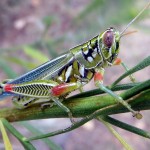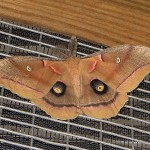This grasshopper caused quite a stir when we first tried to identify her. Clearly a bird grasshopper of some kind, I expected that finding the exact species would be quite easy for such a strikingly colored bug.
Boy, was I wrong. After scouring the internet for hours I finally turned up exactly ONE photograph of a similar looking grasshopper. That picture was taken in Uvalde County just west of San Antonio, but unfortunately the grasshopper in this picture was misidentified.
Next, I began to consult with experts, only to find them stumped on the ID as well. There was some talk that this might be a new species or subspecies of grasshopper previously undocumented.
Eventually, though, it was decided that this must be the aposematic form of the Spotted Bird Grasshopper. Sure. I’ll buy that, but what the heck does aposematic mean?
Well, Aposematic Coloration is simply conspicuous coloration designed to be a warning to predators that there may be unpleasant consequences if the creature with said coloration is disturbed. Skunks have aposematic coloration. So do Monarch Butterflies.
We all know what the skunk is trying to alert us about. The Monarch Butterfly’s defense is its awful taste. So effective is it unpaletablility that several other butterflies mimic the Monarch’s coloration in order to derive the same benefit. The Viceroy is a prime example.
I’m still unsure just what this grasshopper’s coloration is meant to warn of.



Observation Details
| County | – | Dallas |  |
| City | – | Hutchins | |
| Date | – | Oct 12, 2012 | |
| Time of Day | – | Afternoon | |
| Temperature | – | Warm (70-89°F/21-32°C) | |
| Weather | – | Clear | |
| Habitat | – | Recreation-Park | |
| Type of Behavior | – | Stationary | |
| Gender | – | Female | |
| Maturity | – | Adult | |
| Observer | – | Penny Halstead | |
| Main Article | – | Spotted Bird Grasshopper | Observation Location |







Hi Chris, You are probably familiar with grasshopper’s regurgitating their gut contents. This material is toxic in some species. Other grasshoppers have tarsal glands that secrete noxious and toxic agents. Still others are toxic if ingested. I have no idea if any of these phenomena apply to bird grasshoppers. Experiments have shown that hopper species that exhibit these properties are often rejected as prey by both vertebrate and invertebrate predators. Some of these invertebrate predators, such as fire ants, would not be influenced by the coloration, however.
David,
I am going to have to admit to still being more that a little puzzled by this grasshopper. I suppose it’s natural to assume that the aposematic warning must be related to taste or toxicity… some problem associated with eating one of these guys.
But, if this were an effective defensive strategy, I might expect that this form would be the most common for this species. I don’t think it is, though. Maybe it is a new phenomenon and things are still in flux? Interesting to think about.
Chris, evolution is of course a complex phenomenon. I don’t know the details of this grasshopper’s natural history. However, for some species, coloration varies seasonally. Toxicity in grasshoppers is believed to be due to sequestration of toxins from plants. That certainly could vary seasonally. Colors cost energy to produce. It might be beneficial to produce the colors only when they have some chance of being effective. Certain hawks, Swainson’s particularly, are grasshopper specialists. They migrate through Texas, where this particular bird grasshopper is most common, in large kettles in late summer and early fall.
Like you, I am curious as to the reasons for the coloration. However, I am satisfied that it is working for the grasshopper’s benefit. If all or most individuals were so colored while not being toxic then the defense would fail, as visual predators develop what is known as “search image.” If they are reinforced favorably by a morphology, they will respond positively to that morphology over time, even when it becomes relatively rare. Negative reinforcement works similarly — they will continue to avoid the negatively reinforcing stimulus.
Only careful experimentation would tease out all that is happening with the critters. But toxicity is well known in grasshoppers, as is aposematic coloration. Clearly not all grasshoppers exhibit either phenomenon, as your recent blog on a ‘coon feasting on grasshoppers shows.
Chris, if you really want to dig into this, here are a couple of references that might get you started. Though the full text is pricy on the sources linked, the publications should be available in local academic libraries or through interlibrary loan.
http://onlinelibrary.wiley.com/doi/10.1111/j.0014-3820.2002.tb01384.x/abstract
http://www.sciencedirect.com/science/article/pii/S0003347204004099
Interestingly, within _Schistocerca_, life history stage, local population lineage, and population density can influence both toxicity and aposematism.
In case you are unfamiliar with the browser, Google Scholar is an easy internet entry into the scholarly literature on any subject. The main problem is that then it often costs money to actually read the articles found. Resourceful folks have ways around that of course.
Thanks, David. I always appreciate your input. I had not considered that this coloration may come and go, or may only occur under certain conditions. Good thoughts!
I will explore this further… you may have noticed that I have been sitting on these pictures for the better part of a year now. They were taken in October 2012. I’ve been hoping I would stumble across a good explanation for this guy. I’m glad I posted them and got the conversation going again!